
Xenobia Bailey
Paradise Under Reconstruction in the Aesthetic of Funk: The Second Coming
May 15 – June 15, 2024
Opening: Wednesday, May 15th, 6:00 – 8:00 PM
Venus Over Manhattan
39 Great Jones Street
New York, NY 10012
(New York, NY) – Venus Over Manhattan is pleased to present Paradise Under Reconstruction in the Aesthetic of Funk: The Second Coming, the gallery’s debut solo exhibition with artist and cultural activist Xenobia Bailey. This landmark presentation—Bailey’s first solo gallery exhibition in New York City in over two decades—explores her signature method of crochet, featuring some twenty recent and historic works that comprise an immersive installation. Notably, this presentation marks Bailey’s first gallery exhibition since the unveiling of “Funktional Vibrations” in 2015, the artist’s large-scale mosaic commissioned by the MTA for the 34th Street Hudson Yards subway station, one of the largest works ever commissioned by the authority. Staged in advance of Bailey’s participation in the Seattle Art Museum’s exhibition “Poke in the Eye: Art of the West Coast Counterculture,” the exhibition will feature a series of public programs that activate the presentation. Paradise Under Reconstruction in the Aesthetic of Funk: The Second Coming will be on view at 39 Great Jones Street from May 15th through June 15th, 2024.
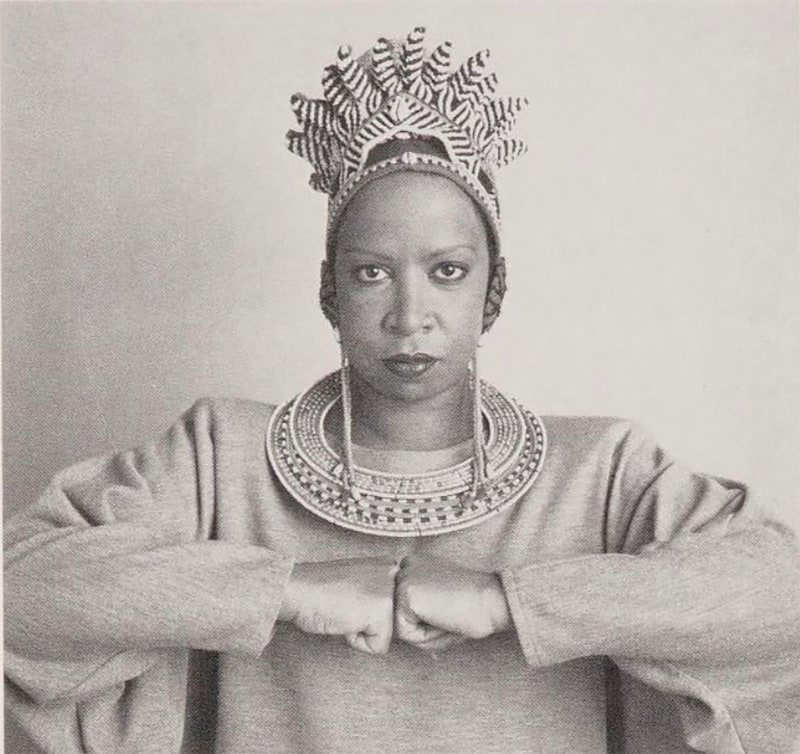
Portrait of Xenobia Bailey, c. 1990s
Xenobia Bailey is celebrated for her intricate work made with hand-crocheted yarn, particularly her vibrant, large-scale mandalas and narrative sculptures, all of which she crochets herself. Her works are characterized by their meticulous design and visual impact, incorporating a wealth of cultural references. Her exhibition at Venus Over Manhattan represents the most recent chapter in her ongoing, exploratory, and research-driven project Paradise Under Reconstruction in the Aesthetic of Funk, a multi-part installation that Bailey has continually developed for nearly three decades. The title references the period of Reconstruction following the Civil War, a time when policies aimed at assimilating African Americans attempted to diminish their cultural identity. Bailey contends that the unfulfilled promises of Reconstruction continue to affect African American families and communities, and her work offers a “remix of Reconstruction” that aims to build upon and extend a distinctly African American aesthetic. She achieves this through complex works that draw upon the history of domestic textiles, referencing the material culture of African American sharecroppers, homemakers, caregivers, and domestic workers.
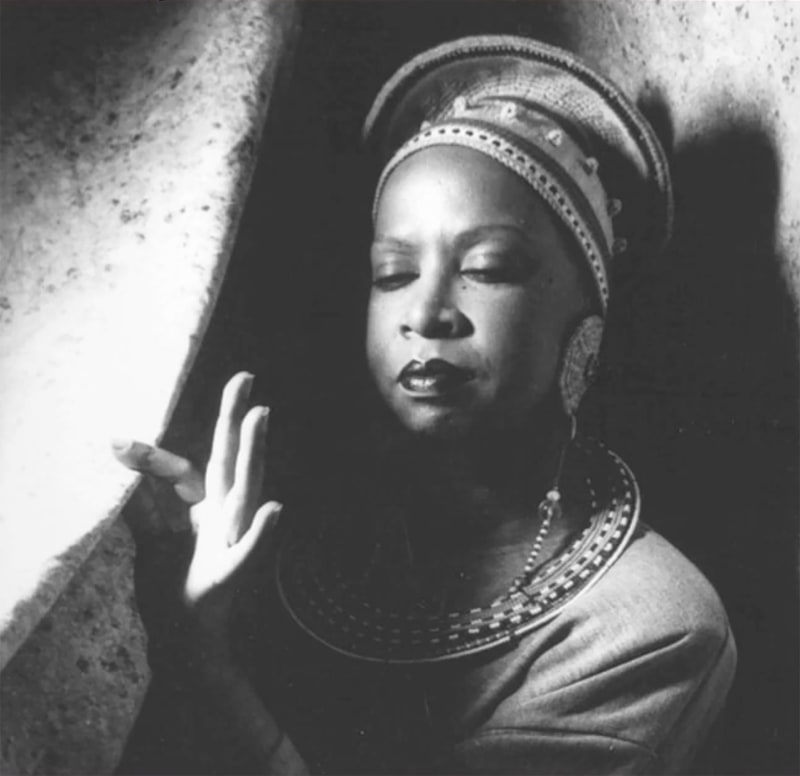
Portrait of Xenobia Bailey, c. 1984
Xenobia Bailey grew up in Seattle, Washington. Her father owned a janitorial business and a pool hall, while her mother worked as a community bus driver and a domestic worker. Inspired by her mother’s skillful domestic talents, Bailey admired how these abilities turned their modest, wood-heated house into a warm and comforting space. She came to view activities such as crafting, crocheting, and interior design not just as creative outlets, but as resilient and resourceful expressions of cultural identity. Supported by affirmative action, Bailey enrolled at the University of Washington, where “her world opened up to her.” She studied ethnomusicology—an inherently interdisciplinary and multicultural department—and took classes with Jacob Lawrence, whose work profoundly impacted her evolving aesthetic. After university, she designed costumes for a theater group called Black Arts/West, before moving to New York in 1974 to attend Pratt Institute, where she pursued industrial design. Following graduation, Bailey met Faith Ringgold, whose integration of personal narrative, cultural history, and fabric gave her license to pursue her own interests. While teaching at a community arts center, she learned how to crochet from Bernadette Sonona, a technique that became the central tenet of her artistic practice. “Crochet is not a high technology,” Bailey notes. “It’s easy and accessible; for under ten dollars you can start crocheting. It’s what you do with those stitches and your imagination that sets it apart.”
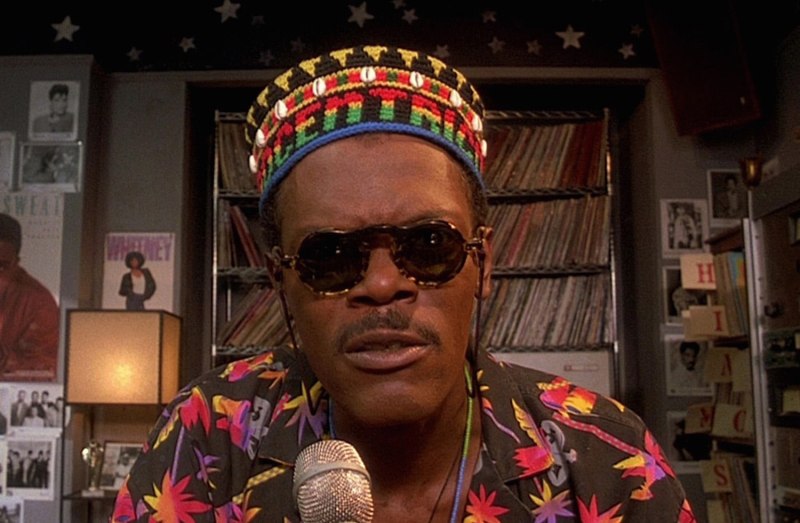
Samuel L. Jackson wearing a hat by Xenobia Bailey in Spike Lee's "Do the Right Thing," 1989.
Bailey’s first major body of crochet work comprised crowns, headpieces, and hats, crafted with her signature “liquid stitch” technique. She conceived these pieces as sculptural forms that merged cultural narratives, Funk, and the spiritual significance of adornment. Drawing inspiration from African hairstyles, architectural forms, and ceremonial headdresses from various cultures, Bailey’s pieces moved beyond conventional crafting to become innovative, wearable sculptures. These works garnered quick attention, leading to features in Elle magazine and high-profile advertising campaigns for Benetton and Absolut Vodka. Her work was featured in Spike Lee’s film, Do the Right Thing, where Samuel L. Jackson wears one of Bailey’s hats emblazoned with the word “Afrocentricity,” embedding her designs in broader narratives of African American culture and style.

Xenobia Bailey, c. 2005.
At the core of Bailey’s work is the idea of “Funk,” and what she sees as its transformative potential for African American culture. For Bailey, Funk represents a celebration of ingenuity and cultural germination, a resistance to conventional norms, and a tribute to the improvisational spirit of creating from scarcity. This ethos is reflected in her work, where she uses materials and techniques that embody these values. Her precedents and inspirations in Funk are pioneers like George Clinton and the Afrofuturistic visions of Sun Ra. Beyond artistic expression, Bailey applies Funk as a transformative tool in urban renewal and community engagement, reimagining spaces with sustainable, Funk-inspired practices that intertwine themes of justice and material inventiveness. This approach positions Funk not merely as an aesthetic category, but as a dynamic, future-oriented framework for cultural reclamation and aesthetic revolution, aiming to preserve African American creativity and foster a sustainable, inclusive future. At base, she understands Funk as the power to animate an object or an environment with whatever one has available.
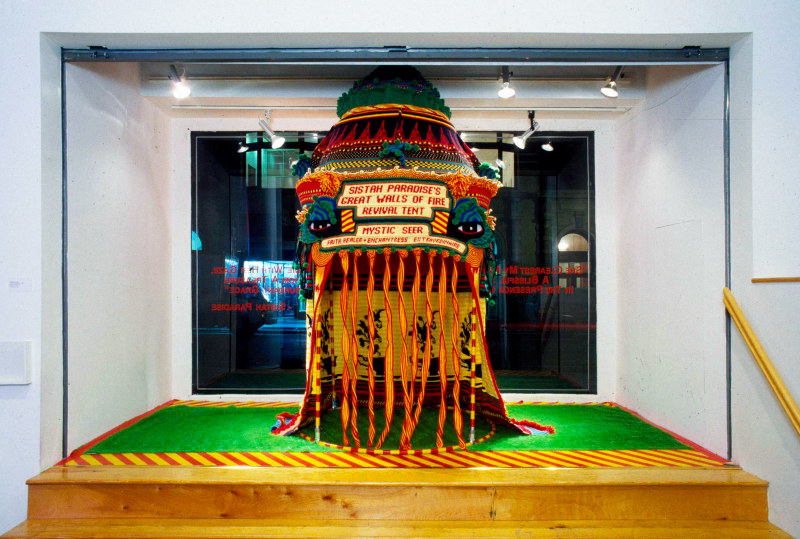
Installation view of Sistah Paradise's Great Walls of Fire Reval Tent (1993/1999/2009), in "Bad Girls," curated by Marcia Tucker, the New Museum of Contemporary Art, New York, 1994.
Xenobia Bailey’s Sistah Paradise’s Great Walls of Fire Revival Tent (1993/1999/2009) began as an extension of her crocheted hats—initiated from a simple circle—and stands as the first and largest of two hand-crocheted tents she has produced. This monumental sculpture—the centerpiece of Bailey’s exhibition—is at once a shelter, a headdress, a tea house, a single occupancy sanctuary, a shrine, an altar, a dragon’s head, and a traditional spiritual revival tent. Central to this piece is a folktale, conceived by Bailey, about Sistah Paradise, a mystical African healer who allowed herself to be captured and brought to the United States. She created a magical tent from the cotton harvested on the plantations, and entering the tent and consuming a special brew could transport the enslaved back to their homeland. While the story of Sistah Paradise’s Great Walls of Fire Revival Tent is a work of fiction, it emerges from Bailey’s extensive research into the transatlantic slave trade and the history of African American material culture. The work conveys deep messages of resilience, imagination, creativity, renewal, and community—themes that resonate through its visual narrative and symbolic significance. First displayed at the New Museum in 1994, the tent has been exhibited around the world, at venues including the Brooklyn Museum, the ICA Boston, SITE Santa Fe, and Nottingham Contemporary.
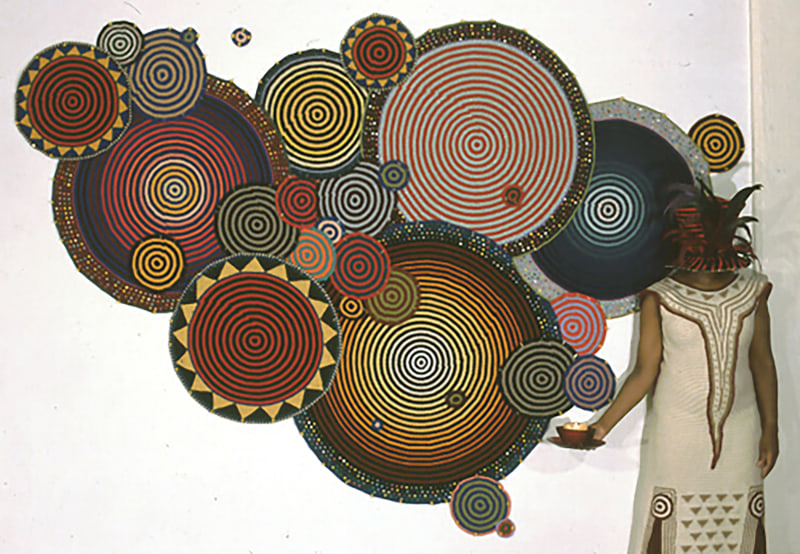
Xenobia Bailey with her work Birthing Suns (1999), c. 2000.
Xenobia Bailey’s wall-mounted mandalas, originating during residencies at the Studio Museum in Harlem and the Atlantic Center for the Arts, extend the visual cosmology of Paradise Under Reconstruction in the Aesthetic of Funk. Initially encouraged by artist Nick Cave to assemble her intricate crocheted elements into expansive compositions, these mandalas transform the gallery walls into a celestial constellation that encircles and complements Sistah Paradise’s Great Walls of Fire Revival Tent. Bailey crochets her mandalas to be meditative tools that invoke the cyclical rhythms of funk music through their vibrant patterns and bold colors, encouraging a meditative state that deepens the viewers engagement with Bailey’s visions of liberation. Together with the revival tent, her works assemble an immersive environment that blurs the boundaries between art and spiritual sanctuary, celebrating cultural identity, and pursuing the betterment of our experience on the planet. These works extend Paradise Under Reconstruction in the Aesthetic of Funk by working to renew a sense of community and self-awareness stifled by historical circumstances, enjoining her viewers to “stand firm, keep your dreams alive, and press on to paradise.”

Xenobia Bailey's sculptural headpieces, circa mid-1980s

From left: Sistah Paradise Crown, 1998. Fulani Brim, 1989. Absolut Bailey, 2003. Zulu Princess, 1989. Portrait of Xenobia Bailey, c. 2000.
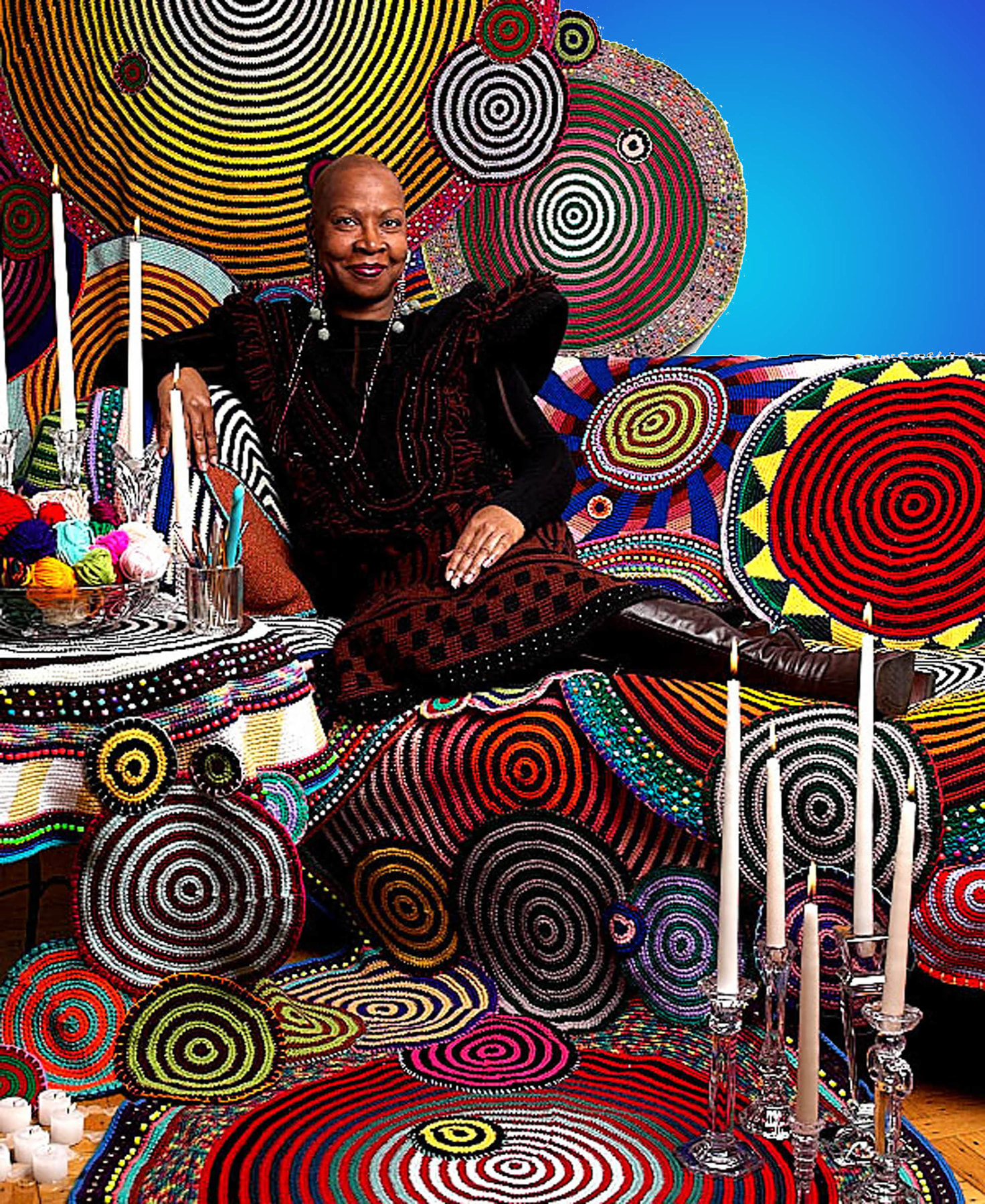
ABOUT XENOBIA BAILEY
Xenobia Bailey was born in 1955 in Seattle, Washington. Between 1970 and 1974, she attended Seattle Central Community College and the University of Washington, Seattle, where she studied with Jacob Lawrence and specialized in ethnomusicology. She received her B.I.D. from Pratt Institute in 1977. Her work has been the subject of numerous solo presentations, including exhibitions at the Brooklyn Museum of Art, Brooklyn; the New Museum of Contemporary Art, New York; the Museum of Arts and Design, New York; Northwest African American Museum, Seattle; the John Michael Kohler Arts Center, Sheboygan; the Fuller Craft Museum, Brockton; the Columbus Museum of Art, Columbus; the Jersey City Museum, Jersey City; the Museum of Fine Arts, Boston; the Allentown Art Museum, Allentown; Rush Arts, New York; Stux Gallery, New York; the Bronx Museum of the Arts, the Bronx; and the Indianapolis Museum of Art, Indianapolis.
Her work frequently features in major group exhibitions at public institutions both stateside and abroad, including presentations at the Studio Museum in Harlem, New York; the Mott-Warsh Collection, Flint; the National Academy of Design, New York; the Saint Louis Art Museum, Saint Louis; the Zimmerli Art Museum, Rutgers University, New Brunswick; the Museum of Arts and Design, New York; the New York Public Library, New York; the Sheldon Museum of Art, Lincoln; Nottingham Contemporary, Nottingham; De La Warr Pavilion, Bexhill-on-Sea; Arnolfini, Bristol; the Museum of the City of New York, New York; BRIC, Brooklyn; the ICA Boston, Boston; Wexner Center for the Arts, Columbus; Des Moines Art Center, Des Moines; Spelman College Museum of Fine Art, Atlanta; Sharjah Art Foundation, Dubai; the Herbert F. Johnson Museum of Art, Cornell University, Ithaca; the Seattle Art Museum, Seattle; the Renwick Gallery of the Smithsonian American Art Museum, Washington, D.C.; the Philadelphia Museum of Art, Philadelphia; Artists’ Space, New York; the Dallas Museum of Art, Dallas, the High Museum of Art, Atlanta; the Milwaukee Art Museum, Milwaukee; and the Virginia Museum of Fine Art, Richmond, among others.
Bailey’s work has been featured in several important films and advertising campaigns, including Spike Lee’s Do the Right Thing and Mo’ Better Blues, several episodes of The Cosby Show and A Different World, campaigns for United Colors of Benneton, and Absolut Vodka. In 1999, Bailey was an artist in residence at the Studio Museum in Harlem. She has received numerous grants and residencies, including fellowships from the New York State Crafts Alliance, the Marie Walsh Sharpe Art Foundation, the National Endowment, the Louis Comfort Tiffany Foundation, the Atlantic Center for the Arts, the New York Foundation for the Arts, the Joan Mitchell Foundation, Creative Capital, the Society for Contemporary Craft, the Nancy Graves Foundation, the Museum of Arts and Design, Anonymous Was A Woman, the McColl Center for Art + Innovation, and BRIC, among many others.
In 2015, Bailey unveiled her mosaic “Funktional Vibrations” above the main entrance of the 34th Street/Hudson Yards subway station, the largest work ever commissioned by the MTA. She frequently receives major public commissions for her work, including recent projects with PSE&G, Newark; the Coney Island Development Fund, Brooklyn; the Spa Beach Pier District, St. Petersburg; the Martin Luther King Jr. Memorial Library, Washington, D.C.; the National Black Arts Theater, New York; and the Association for Public Art, Philadelphia. Her work was featured in “SITElines.2016: New Perspectives on Art of the America,” the 2016 iteration of SITE Santa Fe. Bailey’s work is held in the permanent collections of numerous public institutions, including the Allentown Art Museum, Allentown; Fuller Craft Museum, Brockton; Meta-Open Arts, New York; Museum of Arts and Design, New York: Newark Museum of Art, Newark; Saint Louis Art Museum, Saint Louis; Schomberg Center for Research in Black Culture, New York Public Library, New York; Sheldon Museum of Art, Lincoln; Spritmuseum, Stockholm; and Zimmerli Art Museum, Rutgers University, New Brunswick, NJ. Bailey lives and works in Philadelphia, PA, and New York, NY.
For additional information about the exhibition and availability, please contact the gallery at info@venusovermanhattan.com